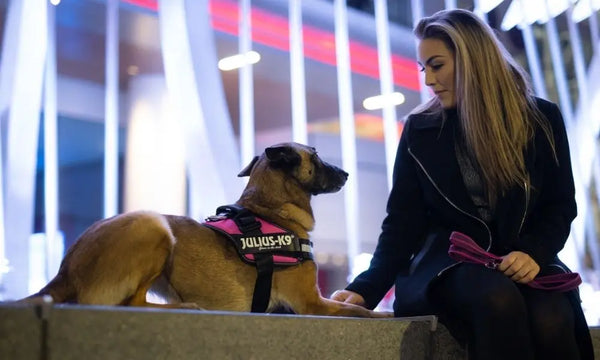Vital Canine Training Techniques for a Lifetime of Etiquette
Efficient canine training is fundamental to fostering a mannerly friend that enriches our lives. Necessary techniques, such as positive reinforcement and constant command training, not only boost obedience however likewise reinforce the bond in between proprietor and pet dog. Furthermore, understanding canine habits and using socializing methods can prevent possible concerns before they emerge. However, the trip does not finish with fundamental commands; resolving behavioral challenges needs a nuanced method that several ignore. What are the crucial elements that can transform your training experience and make sure enduring results?
Recognizing Pooch Actions

Moreover, recognizing the inherent instincts and drives of a pet dog-- such as victim drive, social communications, and territorial habits-- allows trainers to anticipate and manage certain habits. As an example, a dog with a strong victim drive may need various techniques than one that is much more socially inclined.
Furthermore, very early socializing and direct exposure to different atmospheres substantially influence a pet's habits and personality. Positive experiences during critical developmental durations can bring about well-adjusted adult pet dogs, whereas adverse experiences might lead to stress and anxiety or aggression.
Favorable Reinforcement Approaches
Amongst the various pet training techniques, positive reinforcement techniques stick out for their effectiveness and capacity to enhance the bond in between pet dog and instructor (Ohana K9 Academy). This approach highlights rewarding preferred behaviors instead of punishing unwanted ones, promoting a much more participating and relying on partnership
Favorable support can take numerous types, including treats, praise, playthings, or playtime. The key is to supply prompt rewards when the dog shows the wanted actions, enabling them to make the link in between the activity and the positive result. If a canine rests on command, giving a reward right away strengthens that actions, making it extra likely to be repeated.
Uniformity is critical in favorable reinforcement training. Trainers need to use the same cues and incentives to avoid perplexing the dog. Additionally, differing the rewards can maintain the pet dog's interest and inspiration, transitioning from regular deals with to occasional praise or play as the canine masters the behavior.

Fundamental Command Training
Structure on the structure established via positive support techniques, basic command training works as an essential action in establishing an accommodating pet dog. This training usually includes vital commands such as "rest," "remain," "come," and "down - Ohana K9 Academy." Each command plays a crucial role in promoting efficient communication between the pet and its proprietor, improving the general bond
To start fundamental command training, pick a silent atmosphere complimentary from distractions. Start with brief, focused sessions lasting no more than 5 to 10 mins to preserve your pet's interest. Use high-value deals with as benefits, making sure the dog connects correct actions with positive end results. When educating a command, make use of a clear, regular verbal hint gone along with by hand signals to enhance understanding.
Persistence is important; pets might need many repetitions to realize commands fully. Slowly raise the complexity by presenting variations or diversions when your pet dependably responds. Normal practice strengthens found out commands, strengthening them in your pet dog's habits collection. Inevitably, basic find here command training not only cultivates obedience yet likewise improves safety and assists in pleasurable interactions throughout strolls and playtime, preparing for even more innovative training techniques in the future.
Socialization Methods
In the realm of dog training, socializing techniques are essential for cultivating a well-adjusted and positive canine friend. Effective socialization involves subjecting your dog to a variety of environments, individuals, and various other animals in a regulated and positive pop over to these guys manner. The main goal is to aid your canine establish a comfort level with varied experiences, which can considerably lower worry and anxiety in unknown situations.
Begin socialization during the vital developmental home window of 3 to 14 weeks, when pups are most responsive to brand-new experiences. Introduce your pet dog to different settings, such as parks, urban locations, and homes with various other family pets. Make sure these experiences declare by utilizing treats and appreciation to strengthen excellent behavior.
Team training classes are an outstanding means to expose your dog to various other canines and individuals in a structured environment. This permits monitored communications, aiding your pet dog discover appropriate social hints. Routine trips and playdates with courteous pet dogs can even more boost social skills.
Addressing Behavioral Concerns
Attending to behavioral concerns in pets is a vital element of training that needs an organized technique and understanding of canine actions. Common issues such as barking, chewing, hostility, and anxiety can come from different variables, consisting of absence of socializing, inadequate exercise, or even clinical worries.

Furthermore, developing a structured routine that includes normal exercise and psychological click here to read stimulation can considerably reduce behavioral problems. For instance, interactive toys can maintain a pet involved and minimize damaging tendencies. In instances of severe aggression or anxiousness, seeking advice from a specialist dog trainer or a vet behaviorist may be essential.
Verdict
In final thought, effective pet dog training strategies, including positive support, basic command training, and socialization, are important for fostering excellent actions throughout a dog's life. Attending to behavior issues with a methodical strategy not only enhances obedience but also strengthens the bond in between pet dogs and their proprietors.